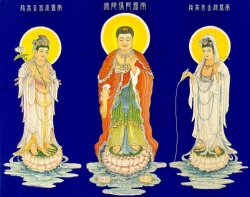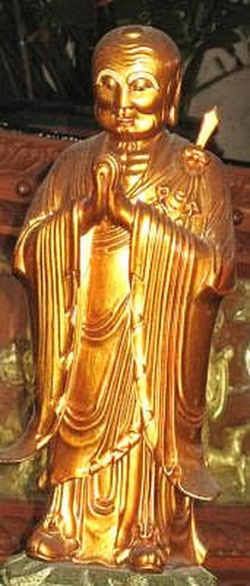Difference between revisions of "Sudassi"
(Created page with "thumb|250px| <poem> Sudassi deva's; Clear-sighted devas One of the Arupyadhatu Devas: The Suddhavasa devas are the [[reb...") |
|||
| (4 intermediate revisions by the same user not shown) | |||
| Line 1: | Line 1: | ||
[[File:Namo A.jpg|thumb|250px|]] | [[File:Namo A.jpg|thumb|250px|]] | ||
<poem> | <poem> | ||
| + | |||
| + | |||
| + | |||
| + | |||
| + | |||
[[Sudassi]] [[deva]]'s; [[Clear-sighted]] [[devas]] | [[Sudassi]] [[deva]]'s; [[Clear-sighted]] [[devas]] | ||
One of the [[Arupyadhatu]] [[Devas]]: | One of the [[Arupyadhatu]] [[Devas]]: | ||
| − | The [[Suddhavasa]] [[devas]] are the [[rebirths]] of [[Anagamins]], [[Buddhist]] [[religious]] practitioners who died just short of attaining the state of [[Arhat]] ([[Brahma Sahampati]], who appealed to the newly [[enlightened | + | The [[Suddhavasa]] [[devas]] are the [[rebirths]] of [[Anagamins]], [[Buddhist]] [[religious]] practitioners who [[died]] just short of [[attaining]] the [[state]] of [[Arhat]] ([[Brahma Sahampati]], who appealed to the newly |
| + | |||
| + | |||
| + | [[enlightened Buddha]] to teach, was an [[Anagami]] from a previous [[Buddha]]). They guard and {{Wiki|protect}} [[Buddhism]] on [[earth]], and will pass into [[enlightenment]] as [[Arhats]] when they pass away from the [[Suddhavasa]] [[worlds]]. The [[highest]] of these [[worlds]] is called [[Akanistha]]. | ||
See [[Suddhavasa]] [[Worlds]] | See [[Suddhavasa]] [[Worlds]] | ||
| Line 15: | Line 23: | ||
A [[Brahma world]], one of the [[Suddhavasa]]. The inhabitants of this [[world]] are friendly with those of [[Akanittha]]. (D.ii.52; M.i.259; D.iii.237; M.iii.103; KhA.120; Vsm.473). | A [[Brahma world]], one of the [[Suddhavasa]]. The inhabitants of this [[world]] are friendly with those of [[Akanittha]]. (D.ii.52; M.i.259; D.iii.237; M.iii.103; KhA.120; Vsm.473). | ||
| + | |||
[[File:Mahakasyapa4.jpg|thumb|250px|]] | [[File:Mahakasyapa4.jpg|thumb|250px|]] | ||
Some [[anagamis]] obtain [[Parinibbana]] in [[Sudassi]]. PSA.319. | Some [[anagamis]] obtain [[Parinibbana]] in [[Sudassi]]. PSA.319. | ||
| − | A [[Pacceka Brahma]] who, with [[Subrahma]], went to visit the [[Buddha]], but, finding him in [[meditation]] during the noonday heat, went to see a certain [[Brahma]] who was infatuated with his own importance. | + | A [[Pacceka Brahma]] who, with [[Subrahma]], went to visit the [[Buddha]], but, finding him in [[meditation]] during the noonday heat, went to see a certain [[Brahma]] who was infatuated with his [[own]] importance. |
They told him of the greater power and majesty of the [[Buddha]], whom they persuaded him to visit. S.i.146. | They told him of the greater power and majesty of the [[Buddha]], whom they persuaded him to visit. S.i.146. | ||
| − | The [[Pure Abodes]]; a name given to a group of [[Brahma worlds]] - the five highest [[Rupa]] [[worlds]] - consisting of | + | The [[Pure Abodes]]; a [[name]] given to a group of [[Brahma worlds]] - |
| − | [[Aviha]], [[Atappa]], [[Sudassa]], [[Sudassi]] and [[Akanittha]] (E.g., D.iii.237). | + | |
| + | the five [[highest]] [[Rupa]] [[worlds]] - consisting of | ||
| + | |||
| + | [[Aviha]], | ||
| + | [[Atappa]], | ||
| + | [[Sudassa]], | ||
| + | [[Sudassi]] and | ||
| + | [[Akanittha]] (E.g., D.iii.237). | ||
There [[anagamis]] are born, and there they attain [[arahantship]]; such [[anagamis]] are divided into twenty four classes (See, e.g., KhA.182f.; of. PSA. 319; Vsm.710). | There [[anagamis]] are born, and there they attain [[arahantship]]; such [[anagamis]] are divided into twenty four classes (See, e.g., KhA.182f.; of. PSA. 319; Vsm.710). | ||
| Line 30: | Line 46: | ||
[[Bodhisattas]] are never born there (SNA.i.50; BuA.224). | [[Bodhisattas]] are never born there (SNA.i.50; BuA.224). | ||
| − | The [[Suddhavasa]] are described as buddhanam khandhavaratthanasadisa. Sometimes, for [[asankheyyas]] of [[kappas]], when no [[Buddhas]] are born, these [[worlds]] remain empty (AA.ii.808; cf. MA.i.30). | + | The [[Suddhavasa]] are described as [[buddhanam khandhavaratthanasadisa]]. Sometimes, for [[asankheyyas]] of [[kappas]], when no [[Buddhas]] are born, these [[worlds]] remain [[empty]] (AA.ii.808; cf. MA.i.30). |
| + | |||
| + | The [[Buddha]] is mentioned as having visited the [[Suddhavasa]] (E.g., D.ii.50). When a [[Buddha]] is about to be born, the inhabitants of the [[Suddhavasa]] insert a [[knowledge]] of the [[signs]] of a [[Great Being]] in the {{Wiki|Vedas}} and teach this among men in the guise of {{Wiki|brahmins}}, calling such [[knowledge]] [[buddhamanta]]. Men learn it and are thus able to [[recognize]] a [[Great Being]] (MA.ii.761; SNA.ii.448). | ||
| + | |||
| + | The inhabitants of the [[Suddhavasa]] know how many [[Buddhas]] will be born in any particular [[kappa]] by observing the number of [[lotuses]] which spring up on the site of the [[Bodhi pallanka]] when the [[earth]] gradually emerges after the destruction of the [[world]] (DA.ii.411). It is the [[Suddhavasa]] [[Brahmas]] who provide the four {{Wiki|omens}} which lead to a [[Bodhisattas]] [[renunciation]] in his last lay [[life]]. See, e.g., DA.ii.455f. | ||
| + | |||
| + | the '[[Pure Abodes]]', are a group of 5 [[heavens]] belonging to the fine-material [[world]] ([[rūpa-loka]], s. [[loka]]), where only the [[Non-returners]] (s. [[anāgāmī]], q.v.) are [[reborn]], and in which they attain [[Arahatship]] and [[Nibbāna]] ([[ariya-puggala]]). | ||
| − | The | + | The names of the inhabitants of these [[Pure Abodes]] are: |
| − | + | [[āviha]], | |
| + | [[ātappa]], | ||
| + | [[Sudassa]], | ||
| + | [[Sudassī]], | ||
| + | [[Akanittha]]. | ||
| − | + | Cf. anāgām | |
</poem> | </poem> | ||
{{R}} | {{R}} | ||
[http://www.wisdomlib.org/definition/suddhavasa-worlds/index.html www.wisdomlib.org] | [http://www.wisdomlib.org/definition/suddhavasa-worlds/index.html www.wisdomlib.org] | ||
| − | [[Category: | + | [[Category:Brahma-worlds]] |
Latest revision as of 20:04, 31 March 2024
Sudassi deva's; Clear-sighted devas
One of the Arupyadhatu Devas:
The Suddhavasa devas are the rebirths of Anagamins, Buddhist religious practitioners who died just short of attaining the state of Arhat (Brahma Sahampati, who appealed to the newly
enlightened Buddha to teach, was an Anagami from a previous Buddha). They guard and protect Buddhism on earth, and will pass into enlightenment as Arhats when they pass away from the Suddhavasa worlds. The highest of these worlds is called Akanistha.
See Suddhavasa Worlds
A Brahma world; one of the Suddhavasa.
Five kinds of Anagamis are born there. M.i.289; D.ii.52; iii.237; KhA.183; VibbA.521; Kvu.207.
A Brahma world, one of the Suddhavasa. The inhabitants of this world are friendly with those of Akanittha. (D.ii.52; M.i.259; D.iii.237; M.iii.103; KhA.120; Vsm.473).
Some anagamis obtain Parinibbana in Sudassi. PSA.319.
A Pacceka Brahma who, with Subrahma, went to visit the Buddha, but, finding him in meditation during the noonday heat, went to see a certain Brahma who was infatuated with his own importance.
They told him of the greater power and majesty of the Buddha, whom they persuaded him to visit. S.i.146.
The Pure Abodes; a name given to a group of Brahma worlds -
the five highest Rupa worlds - consisting of
Aviha,
Atappa,
Sudassa,
Sudassi and
Akanittha (E.g., D.iii.237).
There anagamis are born, and there they attain arahantship; such anagamis are divided into twenty four classes (See, e.g., KhA.182f.; of. PSA. 319; Vsm.710).
Bodhisattas are never born there (SNA.i.50; BuA.224).
The Suddhavasa are described as buddhanam khandhavaratthanasadisa. Sometimes, for asankheyyas of kappas, when no Buddhas are born, these worlds remain empty (AA.ii.808; cf. MA.i.30).
The Buddha is mentioned as having visited the Suddhavasa (E.g., D.ii.50). When a Buddha is about to be born, the inhabitants of the Suddhavasa insert a knowledge of the signs of a Great Being in the Vedas and teach this among men in the guise of brahmins, calling such knowledge buddhamanta. Men learn it and are thus able to recognize a Great Being (MA.ii.761; SNA.ii.448).
The inhabitants of the Suddhavasa know how many Buddhas will be born in any particular kappa by observing the number of lotuses which spring up on the site of the Bodhi pallanka when the earth gradually emerges after the destruction of the world (DA.ii.411). It is the Suddhavasa Brahmas who provide the four omens which lead to a Bodhisattas renunciation in his last lay life. See, e.g., DA.ii.455f.
the 'Pure Abodes', are a group of 5 heavens belonging to the fine-material world (rūpa-loka, s. loka), where only the Non-returners (s. anāgāmī, q.v.) are reborn, and in which they attain Arahatship and Nibbāna (ariya-puggala).
The names of the inhabitants of these Pure Abodes are:
āviha,
ātappa,
Sudassa,
Sudassī,
Akanittha.
Cf. anāgām

